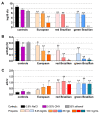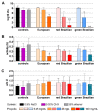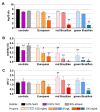In Vitro Activity of Propolis on Oral Microorganisms and Biofilms
- PMID: 34572627
- PMCID: PMC8472590
- DOI: 10.3390/antibiotics10091045
In Vitro Activity of Propolis on Oral Microorganisms and Biofilms
Abstract
Natural products are being discussed as alternatives to commonly used chemicals in antimicrobial therapy. The study aimed to investigate the antimicrobial activity of propolis against microbial species associated with caries, periodontal disease, and Candida infections. Two commercially available ethanolic extracts of Brazilian and one of European propolis (EEP) were used. The minimal inhibitory concentrations (MIC) of propolis and controls against eight microbial strains were determined. Scanning and transmission electron microscopy (SEM and TEM) images visualized the effect of propolis on microorganisms. Subsequently, the activity on three different multi-species biofilms (both formation and existing biofilms) was assessed. All MIC values of the Brazilian EEPs were low against the tested oral species (≤0.1 mg/mL-3.13 mg/mL propolis (Candida albicans)). The European EEP had slightly higher MICs than the Brazilian EEPs. The SEM and TEM images suggest an interaction of propolis with the microbial cell wall. The European EEP exhibited the strongest effect on retarding biofilm formation, whereas the Brazilian EEPs were highly active against preformed biofilms (100 mg/mL propolis of both EEPs reduced colony forming unit counts always by more than 6 log10). The antimicrobial and anti-biofilm activities point to the potential of propolis as an adjunct in oral health care products.
Keywords: candidiasis; caries; minimal inhibitory concentrations; oral multi-species biofilm; periodontal disease; propolis preparations.
Conflict of interest statement
The authors declare no conflict of interest. The funder had no role in the design of the study; in the collection, analyses, or interpretation of data; in the writing of the manuscript, or in the decision to publish the results.
Figures








References
-
- Chapple I.L.C., Mealey B.L., Van Dyke T.E., Bartold P.M., Dommisch H., Eickholz P., Geisinger M.L., Genco R.J., Glogauer M., Goldstein M., et al. Periodontal health and gingival diseases and conditions on an intact and a reduced periodontium: Consensus report of workgroup 1 of the 2017 World Workshop on the Classification of Periodontal and Peri-Implant Diseases and Conditions. J. Clin. Periodontol. 2018;45:S68–S77. doi: 10.1111/jcpe.12940. - DOI - PubMed
-
- Papapanou P.N., Sanz M., Buduneli N., Dietrich T., Feres M., Fine D.H., Flemmig T.F., Garcia R., Giannobile W.V., Graziani F., et al. Periodontitis: Consensus report of workgroup 2 of the 2017 World Workshop on the Classification of Periodontal and Peri-Implant Diseases and Conditions. J. Clin. Periodontol. 2018;45:S162–S170. doi: 10.1111/jcpe.12946. - DOI - PubMed
-
- Buonavoglia A., Leone P., Solimando A.G., Fasano R., Malerba E., Prete M., Corrente M., Prati C., Vacca A., Racanelli V. Antibiotics or No Antibiotics, That Is the Question: An Update on Efficient and Effective Use of Antibiotics in Dental Practice. Antibiotics. 2021;10:550. doi: 10.3390/antibiotics10050550. - DOI - PMC - PubMed
Grants and funding
LinkOut - more resources
Full Text Sources
Molecular Biology Databases

